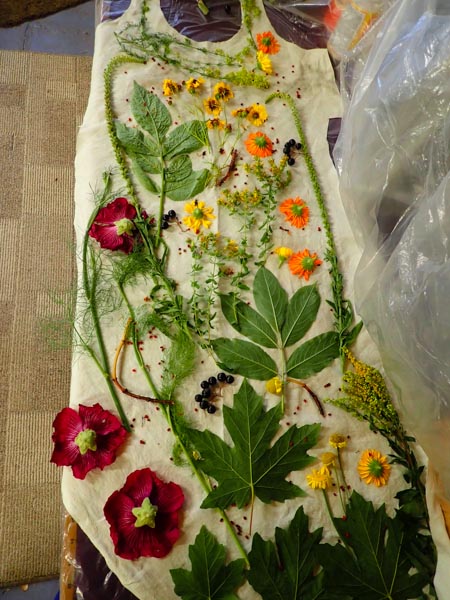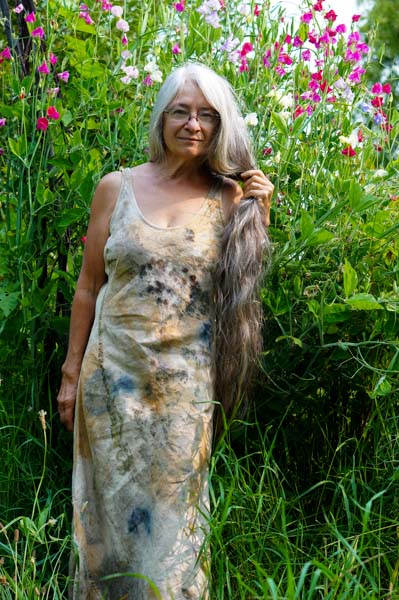Plants of Many Colors!
Below is a list of some of the dye plants grown at Barbolian Fields. I don’t grow a lot of any one thing, but I might have extra to share. Availability varies from year to year. Please contact us if you are interested.
Dye Plants for 2022
- Agrimony (Agrimonia eupatoria)
- Alder (Alnus spp.)
- Basil (Ocimum basilicum)
- Berberis / Red Barberry (Berberis thunbergii)
- Broom, Dyer’s; aka Dyer’s Greenweed, Woadwaxen, Broom (Genista tinctoria)
- Calendula / Pot Marigold (Calendula officinalis)
- Coreopsis (Coreopsis tinctoria and others)
- Cosmos (aka Mexican Star) (Cosmos bipinnatus)
- Crocosmia, aka Montbretia (Crocosmia aurea)
- Curly Dock (Rumex crispus)
- Dahlia (Dahlia coccinea)
- Fennel, wild & bronze (Foeniculum vulgare)
- Golden Marguerite, aka Dyer’s Chamomile (Anthemis tinctoria)
- Goldenrod (Solidago spp.)
- Grapes (Vitis spp.)
- Gum Plant (Grindelia robusta)
- Gypsywort (Lycopus europaeus)
- Hollyhock (dark varieties) (Alcea rosea)
- Hops (Humulus lupulus)
- Indigo (Indigofera tinctoria, aka Indigoferum tinctorium)
- Indigo, Blue False (Baptisia australis)
- Indigo, Japanese (Persicaria tinctoria, aka Polygonum tinctorium)
- Kinnikinnick, bearberry (Arctostaphylos uva-ursi)
- Lady’s Bedstraw (Galium verum)
- Loquat (Eriobotrya japonica)
- Madder (Rubia tinctorum)
- Marigolds (Tagetes spp.)
- Meadowsweet (Filipendula ulmaria; Spirea ulmaria)
- Mugwort (Artemisia vulgaris)
- Mullein (Verbascum thapsus – L.)
- Navajo Tea (Cota, Hopi Tea, Greenthread, Field Coreopsis) (Thelesperma filifolium)
- Nettles (Urtica dioica)
- Oregon Grape (Mahonia aquifolium)
- Osage Orange (Maclura pomifera)
- Rhubarb (Rheum spp.)
- Rudbeckia / Black-eyed Susan (Rudbeckia fulgida)
- Safflower Zanzibar (Carthamus tinctorius)
- Saint John’s Wort (Hypericum perforatum)
- Scabiosa, Purple Pincushion (“Black Knight”) (Scabiosa Purpurea)
- Siberian Pea Shrub (Caragana arborescens)
- Strawberry Tree (Arbutus unedo)
- Sunflowers, Hopi Black Dye and others (Helianthus annus)
- Sweet Woodruff (Galium odoratum)
- Tarragon, Mexican (Tagetes lucida)
- Tithonia, Mexican Sunflower “Torch” (Tithonia rotundifolia)
- Weld (Reseda luteola)
- Willow (Salix spp.)
- Woad (Isatis tinctoria)
- Yarrow (Achillea millefolium)
Top Dye Plants
Dyeing fabric and fibers with plants is a rather long process (especially if dyeing cellulose fibers, like linen). With all the work involved, I prefer to focus on those plants that reliably give strong, long-lasting colors. Different tannin sources, mordants, and pH shifters are all topics too large for this page – but I will share some of my experiments in the pages to come.
My three top plants for longevity and for achieving primary colors are madder, weld, and woad – red, yellow, blue. Walnut husks are easy for browns to blacks.
I have also had good results with coreopsis, dahlias, golden Marguerite, goldenrod, hollyhocks, marigolds, acorns & willows (primarily for tannins), osage orange, and safflowers (although they are a bit fiddly to work with) – and I would recommend these to beginners.
Experimenting Is Half the Fun
So many plants; so little time! However, just because a plant produces a dye doesn’t mean it’s ideal for your purpose. But how will you know unless you try?
For example, I used to grow a fair amount of the Hopi Red Dye Amaranth – which sounds like a no-brainer – but I did not find it to be a dye that lasted very long – good with food, but not so great with fabric. Sunflowers have also given me mixed results. I am not ready to give up on these plants!
Hey, if it doesn’t work, you can always over-dye it. Same with if it fades. You might come up with even more interesting blended color combinations!
Although dye plants have been my passion for many years, I still consider myself a beginner, and perhaps always will be. Many of these plants I grow I haven’t even tried yet (I need another lifetime for all this experimentation!)
I only dye with what I can grow or sustainably wildcraft (I’m not using insects, for example). Also, I do not use harsh chemicals for mordants.
Recently, I have been experimenting with foraged mushrooms and lichens and trying eco-dyeing techniques on linen and silk, which is rather exciting. More on all of this in pages to come!
Thanks for checking back in!
~ * ~
-blythe
References & Resources
I own or have read all but one of the books listed below and can highly recommend them. I was surprised to find how many of them were available through our small-town public library. They are also available through Amazon (affiliate links) or your local bookstore. For some reason, the links are sometimes unstable on the website and I get an “internal server error” message. If I come back later, it sometimes reappears! Such internet and website mysteries often baffle me, but I have provided an additional link in the description below each one in case you are interested in more info or purchasing. Thanks!
A Dyer’s Garden was one of my very first dye plant books (published in 1995). It has inspired me to grow so many different colors! I still refer to it.
I have the earlier version of Wild Color published in 1999. It was my go-to for many years. I’m sure this more recent version (2010) is even better! I am a big fan of Jenny Dean. My tip is to bookmark the page that explains the icons representing the different modifiers and mordants until you get used to them, because you will keep going back to find it.
Many thanks to Joy Boutrup & Catharine Ellis for The Art and Science of Natural Dyes – a very thorough book! I admit, it has made me want to learn more chemistry! So nice to have a reference that explains it so clearly. And I love the ring binding that allows you to lay it flat while following directions. And now they have The Studio Formulas Set: 84 Recipe Cards to accompany the book! Hmm. I might have to check that out!
I live in the Pacific Northwest, the Land of Lichens! But lichens can be tricky to identify and they are often in short supply and growing in sensitive environments. Lichen Dyes is inexpensive and is a great resource! But you might need an additional book for identification purposes.
We also live in the land of mushrooms. The Rainbow Beneath My Feet will make you look down through forest and field and truly expand your color wheel. I love this book. I take it with me hunting. For mushrooms, of course.
The Mushroom Color Atlas is a brand new book published in 2024 and I have not yet read it, but it has great reviews. I can’t even imagine all the work the author must have gone through to create such an encyclopedia!
New books are coming out all the time. Do you have a favorite not listed here? Let me know!
And so much inspiration and helpful people online, too! I can’t even begin to list them all! Botanical Colors and Maiwa free tutorials have definitely been helpful for me. But for pure joy, inspiration, and grounded knowledge, also be sure to check out Lost in Colors — written by “a scientist and a watercolor artist dedicated to sustainability,” living in Austria, Jyotsna explores plants, dyes, lake pigments, inks, ecoprints, indigo extraction methods, painting, gardening, and so much more. Thank you, Jyotsna!
(P.S. Yes, the above books are affiliate links through Amazon. Thanks so much for your support! But I also fully support your supporting your local bookstore! One of my favorite independent publishers is Chelsea Green. Enjoy!)
~ * ~

